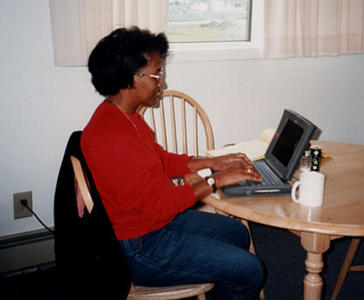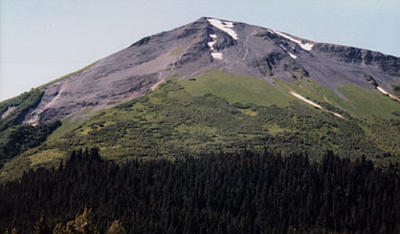
|
|
21 July, 1998
Myrtle Brijbasi
TEA/Alaska - 98
Journal Entry 12 - July 21, 1998
Alaska SeaLife Center, Ak
Noa is very excited about today. Why? It is her rotation to work in
the outdoor lab and feed the otters. But that's not the main reason. It's
draining and scrubbing the pools day, and best of all Noa gets to wear and
model her beloved, fashionable rain gear ALL DAY LONG. WHAT A THRILL!
As usual, the daily routine was carried out where Noa, Olav and
Susanne cleaned the outdoor lab, counted fecal pellets, emptied, clean and
refilled their totes with water, and changed and laundered blankets. They
also fed the otters their morning supply of fish which the otters devoured
without hesitation. Elisa and I observed the otters and recorded
information. Following that, Olav drained the pools. The otters being
aware of out-of-the normal-routine stayed in their dens most of the time,
coming out occasionally to excrete, or drink water.
Following the draining of the pools, Susanne and Olav took turns
using a power hose to scrub the algae from the walls of the pools. Later
Elisa and I joined them in the outdoor lab, stepped into the large pool
(now void of water) and started scrubbing the walls and floor. We took a
lunch break and upon our return we scrubbed the individual pools in the
kennels. We did a thorough job and among the five of us we were done in
about 4 hours. The pools are drained and cleaned every 10 days. Prior to
draining and cleaning, a sample of the water from each of the pools is
collected and tested for quality control purposes. In addition, the test is
repeated the day after cleaning and replenishing of water in the pools for
any evidence of unfriendly, unwanted, and uninvited guests -microorganisms.
It was a remarkable difference in the clarity of the water after the pools
were cleaned. It was an excellent example of how much algal growth occurs
in a relatively short time in a nutrient rich environment.
All of the outdoor pools at the Sea Life Center receive a constant
flow of water from Resurrection Bay at a rate of five thousand gallons per
minute. The flow system of the water intake which is achieved via siphon
systems is rather interesting, and technologically sophisticated. This
whole mechanism is described as a master piece of engineering. The
functioning of the electronic faucets and the heating-cooling systems are
all linked to the flow of water from the bay into the building.
Furthermore, the system efficiently serves the purposes of research as well
as provides adequate levels of water for exhibits. For additional
information about the construction of the SeaLife Center, visit its web
site at http://www.alaskasealife.org/
Since I finished cleaning my small pool first, Dr. Ben-David gave
me the opportunity to assist another research scientist - ornithologist,
Dr. George Divoky. He was rehabilitating pigeon guillemot chicks of
different ages. I helped with the recording of the data as he fed them with
different fish of specific weights in relation to the bird's body size. The
fish he used were herring, pollock, and small fry (salmon). The fish were
also rehydrated before feeding them to the birds (injected with water via
anus). It was an interesting experience to watch these chicks consume
whole fish - 4-6 inches long, in just a few seconds. It was like suction-cup
response..... reptilian almost. The stomachs of these chicks are described
as large expanding bags.
I later rejoined the other members of my team, who by then had
completed the work in the outdoor labs. The remaining time for the day was
spent observing the otters, and to watch them swim gracefully in the clean,
clear, pools. See you tomorrow and I am sure I will have some more exciting
and interesting information to share with you about our research
experiences at the SeaLife Center.

Writing journals on my computer in our room. Note that you can see the SeaLife Center storage facilities and outdoor animal quarters through the window.

The treeline and alpine tundra ecotones are easily visible on Mt. Marthon, as seen from the 'observation deck' at the SeaLife Center.
Contact the TEA in the field at
.
If you cannot connect through your browser, copy the
TEA's e-mail address in the "To:" line of
your favorite e-mail package.
|
